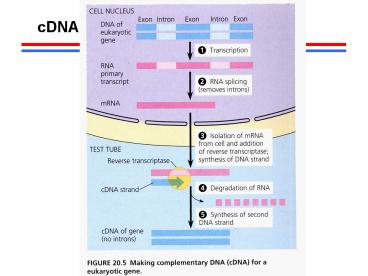cDNA PowerPoint PPT Presentation
1 / 32
Title: cDNA
1
cDNA
2
(No Transcript)
3
- ?0? N15 (100)
- ?1? N14N15 (100)
- ?2? N14 (50), N14N15 (50)
- ?3? N14 (75), N14N15 (25)
- SEMICONSERVATION
4
- ???ds DNA???????
5
- The replication fork is where the action is!
6
- Consensus seq.
- -10 TATAAT
- -35TTGACA
- Conversed seq.
- Motif
- Active site
- Catalytic domain
- Amino acid seq.
7
DNA/RNA???
- dATP
- ATP
- 5 ATGCCTAGTAATGCC 3
- 5 AUGCCUAGUAAUGCC 3
8
1) An effector (like lactose) binds the repressor
protein, 2) The repressor is removed from the
DNA3) This allows RNA polymerase to bind DNA and
make mRNA.
9
Regulator binding to the operator sequence of DNA
prevents RNA Polymerase from binding the DNA
promotor sequence and thereby prevents it from
making mRNA from the DNA. When effector (lactose
catabolite) binds the regulator it is removed
from DNA making mRNA production possible.
10
Glucose is the preferred bacterial fuel, but if
it isnt present cAMP accumulates! cAMP
activates CataboliteReactiveProtein(CRP).
CRP-cAMP then binds DNA and improves the
affinity of RNA polymerase for the initiation
sequence of the lac-operon, improving the
bacterial ability to use lactose as fuel.
11
(No Transcript)
12
(No Transcript)
13
(No Transcript)
14
- Coupled translation and transcription
15
(No Transcript)
16
??
???????????????????promoter, 5'UTR(untranslated
region), exons, introns, 3UTR, polyadenylation
site?????exon???????????????? ????????????????DNA?
???? start codon, stop codon, ? splicing
site(??donor ?acceptor sites),??????????exon????,?
??? ??????????????
http//140.112.78.220/juang/
17
(No Transcript)
18
???Nucleotide???
?? (??)????
http//ac220.ac.ntu.edu.tw/7Ejuang/JRH/biotech.ht
m
19
???Nuleotide
20
?????
http//www.yangene.com/chinese_protein1.htm
http//140.112.78.220/juang/
21
20??????
aspartic acid (D)
glutamic acid (E)
valine (V)
leucine (L)
methionine (M)
isoleucine (I)
phenylalanine (F)
tyrosine (Y)
tryptophan (W)
aspargine (N)
glutamine (Q)
serine (S)
threonine (T)
glycine (G)
lysine (K)
histidine (H)
arginine (R)
cysteine
proline
alanine (A)
2
3
know all of them for this course!
22
- Okazaki fragment
- ??1000-2000 nucleotides
- ??100-200 nucleotides
23
- The anticodons of some tRNAs recognize more than
one codon. - 41 tRNA species (instead of 61)
- Base pairing between the base at the third codon
position and the first anti-codon position is
more relaxed (wobble)
24
DNA?RNA???
- ?sugar
- Ribose
- deoxyribose
- ????base
- ??Purine,A, G
- ??Pyrimidine,T, U, C
- DNA double strand
- RNA single strand
25
????????
- ?????????????
- ???????,??????
- ??????????????
- ??,??????
26
- DNA?????????5?3?
- ??????dNTP???????
- 5???dNTP,?DNA polymerase I??(Proofreading)
- ????
- ?????
- ???????
- DNA??????
- DNA plymerase ??3OH
27
- DNA???????????????????
- ?????5?3
- Leading strand???????
- Lagging????????
- ????????
28
- E. coli??DNA????2,000 nucleotides/sec,??????genome
(4.2106)????? - (4.2106)/(22000)1,050 sec
29
- Consensus seq.?????????
- ???????,????????????,????????,??,???????PROMOTER?,
???-10???TATA box,???TATAAT,-35???TTGACA? - Conserved seq. (region) ?????
- ???????????(???)?,????????,???????,????????,??????
?,??????active site?catalytic domain?binding
site??????????,???????????????????
30
- mRNA
- ?????????,?????????
- rRNA
- ?????,????????
- tRNA
- ?????????????,???????????
31
22424128
32
Protein Folding and Modifications
- Protein folding
- Proteins must be properly folded for function
- Unfolded proteins are insoluble and unstable
- Post-translation modifications
- May be required for protein function
- case by case basis
- Correct disulfide bonds
- Proteolytic cleavage of inactive precursor
- Glycosylation (addition of sugars)
- Phosphorylation, sulfatation, acetylation
- phosphorylation, glycosylation

